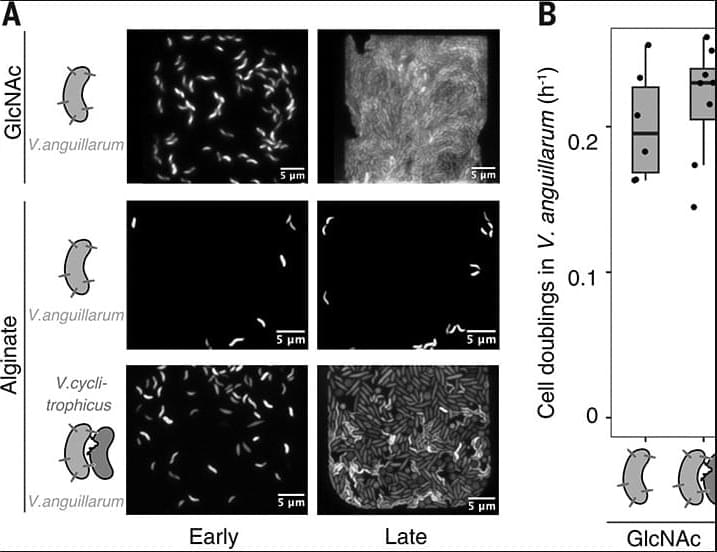Pillar Security unveils full-lifecycle AI platform securing assets from design to runtime—critical for safe AI deployment.






Fascinating paper where the authors show that many bacteria can attack other ‘prey’ bacteria (using T6SS as a weapon) and feed on the nutrients released by the destroyed prey. This behavior appears widespread across environments such as soil, ocean, etc.
In natural habitats, nutrient availability limits bacterial growth. We discovered that bacteria can overcome this limitation by acquiring nutrients by lysing neighboring cells through contact-dependent antagonism. Using single-cell live imaging and isotopic markers, we found that during starvation, the type VI secretion system (T6SS) lysed neighboring cells and thus provided nutrients from lysing cells for growth. Genomic adaptations in antagonists, characterized by a reduced metabolic gene repertoire, and the previously unexplored distribution of the T6SS across bacterial taxa in natural environments suggest that bacterial antagonism may contribute to nutrient transfer within microbial communities in many ecosystems.

Microsoft is reportedly in advanced talks with OpenAI for a new agreement that would give it ongoing access to the startup’s technology even if OpenAI achieves what it defines as AGI, or advanced general intelligence. If the deal goes through, it would clear a key hurdle in OpenAI’s transition toward becoming a fully commercial enterprise.
The companies have been negotiating regularly, and they could come to an agreement in a few weeks, Bloomberg reports, citing three anonymous sources. The report cited some of the sources as saying that while the talks have been positive, other roadblocks could emerge in the form of regulatory scrutiny and Elon Musk’s lawsuit to block OpenAI’s for-profit transition.
OpenAI is currently structured as a mission-driven nonprofit that oversees a capped for-profit company — a setup that’s meant to limit how fully it can commercialize or raise money. That structure hasn’t stopped it from raising billions and operating like a traditional tech company, but OpenAI still wants to shake off its constraints.
Basically there are three meteorites in our solar system that may pass by earth but most likely far away from the earth. Even though this news site says it may hit earth I am not quite certain it will.
Asteroid 2025 OW, the size of a skyscraper, is tearing through space next week—and it’s coming perilously close to Earth. NASA says no impact risk this time, but astronomers are sounding the alarm: these cosmic flybys are more frequent and more dangerous than you think. See why we dodged disaster and what happens if luck runs out.
#asteroid #earth #wion.
About Channel:
WION The World is One News examines global issues with in-depth analysis. We provide much more than the news of the day. Our aim is to empower people to explore their world. With our Global headquarters in New Delhi, we bring you news on the hour, by the hour. We deliver information that is not biased. We are journalists who are neutral to the core and non-partisan when it comes to world politics. People are tired of biased reportage and we stand for a globalized united world. So for us, the World is truly One.

The cerebral cortex processes sensory information via a complex network of neural connections. How are these signals modulated to refine perception? A team from the University of Geneva (UNIGE) has identified a mechanism by which certain thalamic projections target neurons and modify their excitability.
The work, published in Nature Communications, reveals a previously unknown form of communication between two regions of the brain, the thalamus and the somatosensory cortex. It could explain why the same sensory stimulus does not always elicit the same sensation and open up new avenues for understanding certain mental disorders.
The same sensory stimulus can be perceived clearly at times, and remain vague at others. This phenomenon can be explained by the way the brain integrates stimuli. For example, touching an object outside our field of vision may be enough to identify it…or not.

Titanforge 3D Printing & Hobbies will open in downtown Harrisonburg on Friday, bringing cutting-edge technology to the forefront of the city’s cultural district.
For weeks, the massive Elegoo Giga 3D printer in the shop’s front window has elicited excitement from people walking along Main Street near Court Square, with passersby wondering what the huge device could be printing. On Friday, Titanforge will hold its grand opening, giving community members the opportunity see what can be made when materials are piled over three feet high on a 2.6-foot square printing bed.
The shop, spearheaded by Erin Tutwiler, manager of Titanforge, will offer 3D-printed tabletop gaming accessories as well as other retail supplies like trading cards, dice, and game mats. Two kittens, named Titan and Forge, will also be present to greet customers.

Artificial Intelligence (AI) is usually built with silicon chips and code. But scientists are now exploring something very different. In 2025, they are growing brain organoids, which are small, living structures made from human stem cells. These organoids act like simple versions of the human brain. They form real neural connections and send electrical signals. They even show signs of learning and memory.
By linking organoids with AI systems, researchers are beginning to explore new computational approaches. Recent studies have shown that organoids possess the ability to recognize speech, detect patterns, and respond to input. Living brain tissue may help create AI models that learn and adapt faster than traditional machines. Early results indicate that organoid-based systems could offer a more flexible and energy-efficient form of intelligence.
Brain Organoids and the Emergence of Organoid Intelligence.